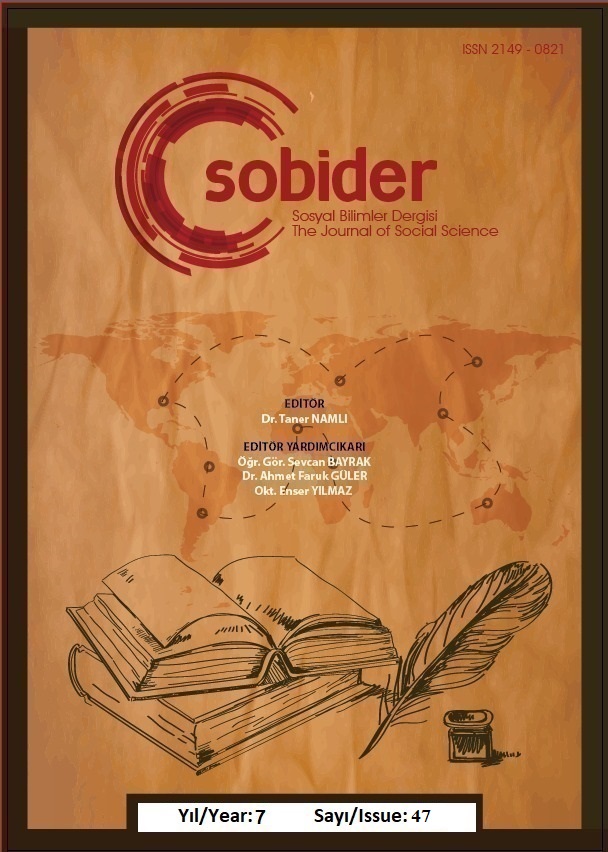Author :
Abstract
Toplumun düşünce ve davranış biçiminin giyime yansıması olan ve zaman zaman değişiklik gösteren yenilik olarak tanımlanan moda ve bunun özgün bir şekilde dışa yansıtılması olarak tanımlanan sanat arasında geçmişten günümüze değin yakın bir ilişki olduğu bilinmektedir. Popüler kültürün bir ürünü olarak ortaya çıkan pop-art sanat akımının da giysi tasarımı üzerine yansımaları 1960’lar ve sonrasından başlayarak günümüze kadar olan süreçte hala görülmektedir. Tüketim toplumunun özellikle 60’lı yıllarda ilgi odağı haline gelen objeleri birer tasarım unsuru haline getirmesi de yine bu sanat akımının ortaya çıkmasında etkili olmuştur. Popüler kültürün etkiledeği alanlardan birisi olan moda, bireylere farklı görünme olanağı sunarak, onları popüler kültürün bir parçası haline getirmekte ve içerisinde çözümlenmesi gereken bir takım kodlar içermektedir. Bireylerin yaşam tazları hakkında bilgi veren bu kodların ise çözümlenmesi gerekmektedir. 17. yüzyılda ilk adımları atılmaya başlanan semiyoloji (göstergebilim) kavramı göstergelerin yorumlanmasına, işaretlerin incelenmesine ve elde edilen bilgilerin sistematik bir şekilde sıralanmasına dayanan bir disiplindir. Semiyoloji denince akla gelen iki isimden biri olan Roland Barthes göstergebilimin toplumsal işlevini, bir diğer isim olan Charles Sanders Peirce ise mantıksal işlevini sorgulamaktadır. Bu çalışma kapsamında bilimsel bir metod olarak kabul edilen göstergebilim yöntemi ile kadın giysilerinde pop-art sanat akımının etkileri incelenmiştir. Araştırmada, Peirce ve Barthes’ın göstergebilim analizlerinden yararlanılarak görseller yorumlanmıştır.
Keywords
Abstract
It is known that there is a close relationship between fashion, which is defined as a novelty that reflects the way society thinks and behaves in clothing and change from time to time, and art, which is defined as an original outward reflection from the past to the present. The reflections of the pop-art art movement that emerged as the product of popular culture on clothing design continue from the 1960s to the present day. The fact that consumer society made objects a design element, especially in the 60s, the center of attention, was also instrumental in the emergence of this art movement. Fashion, which is one of the areas influenced by popular culture, offers individuals the opportunity to look differently, making them a part of popular culture and contains a set of codes that need to be resolved. The concept of semiotics, the first steps of which were taken in the 17th century, is a discipline based on the interpretation of the signs, the examination of the signs and the systematic ordering of the information obtained. Roland Barthes, one of the two names that comes to mind when it comes to semiology, questions the social function of semiology, and Charles Sanders Peirce, the other name, questions its logical function. In this study, the effects of pop-art Art movement on women's clothing were examined by the semiotics method, which is considered a scientific method. In the research, visuals were interpreted by using semiotics analysis of Peirce and Barthes.
Keywords
- Çağlar, B. (2012). Bir iletişim biçimi olarak göstergebilim. EUL Journal of Social Sciences, 22- 34.
- Kırkıncıoğlu, Z. (2015). Ege Bölgesi kadın giyim-kuşamının göstregebilimsel yöntem ile çözümlenmesi. Yayınlanmamış doktora tezi, Gazi Üniversitesi Eğitim Bilimleri Enstitüsü, Ankara.
- Köroğlu, A. Serdar (2015). Literatür taraması üzerine notlar ve bir tarama tekniği. GİDB dergi, 1, 61-69.
- Merriam, S. B. (2013). Nitel araştırma: Desen ve uygulama için bir rehber (Çeviri Edit.: S. Turan). Ankara: Nobel Yayın Dağıtım.
- Özdem, Ö. O. (2013). Postmodern sanat akımları ve reklamlara yansımaları . İletişim Kuram ve Araştırma Dergisi, s. 42.
- adresinden 15.05.2020 tarihinde erişilmiştir.
- Rosenblum, R. (2001). Sanatı ve yaşamıyla Andy Warhol (Edt. Esra Aliçavuşoğlu, Çev. Tuncay
- Şoher, B. (2012). Moda tasarımı eğitiminde sürrealizm sanat akımının öğrencilerin yaratıcıklarına etkisi. Yüksek Lisans Tezi, Gazi Üniversitesi Eğitim Bilimleri Enstitüsü, Ankara.
- Usluca, Ö. (2012). Giyim modası ve güncel sanat ilişkisi üzerine bir değerlendirme Pop Art, Akdeniz Sanat Dergisi, 4(7), 44-47
- Üstündağ, C. (2012). Pop Art akımının postmodernizm ile ilişkisi ve tekstil modasına uyarlanması. Yüksek Lisans Tezi, Haliç Üniversitesi Sosyal Bilimler Enstitüsü, İstanbul.
- Yılmaz, A. H. (2016). Türklerde ölüm anlayışının çağdaş türk resminde gösterge bilimsel açıdan incelenmesi. Sanatta Yeterlilik Tezi, Süleyman Demirel Üniversitesi Güzel Sanatlar Enstitüsü, Isparta.
- Yüksel, Ş. (2013). Atıştırmalık ürün reklamlarının gösterge bilimsel açıdan incelenmesi, Yüksek Lisans Tezi, Selçuk Üniversitesi Sosyal Bilimler Enstitüsü, Konya.
- Yüret, Z. (2013). Yaşamdaki nesnelerin sanat eserine dönüştürülmesi. Yüksek lisans tezi,





